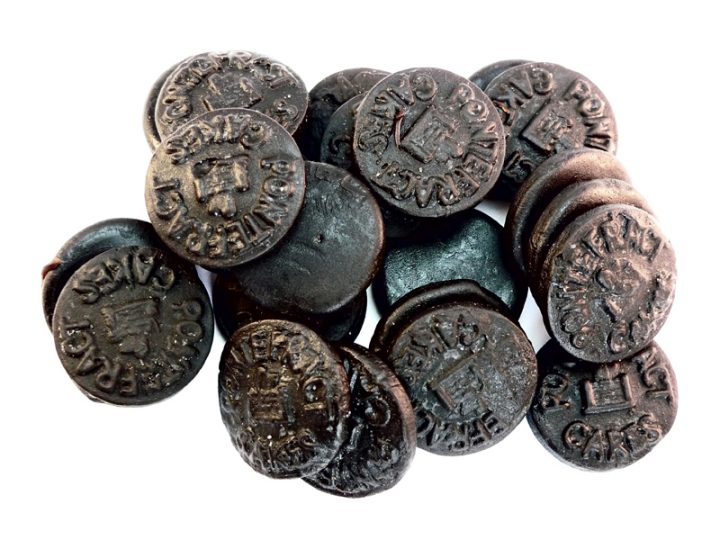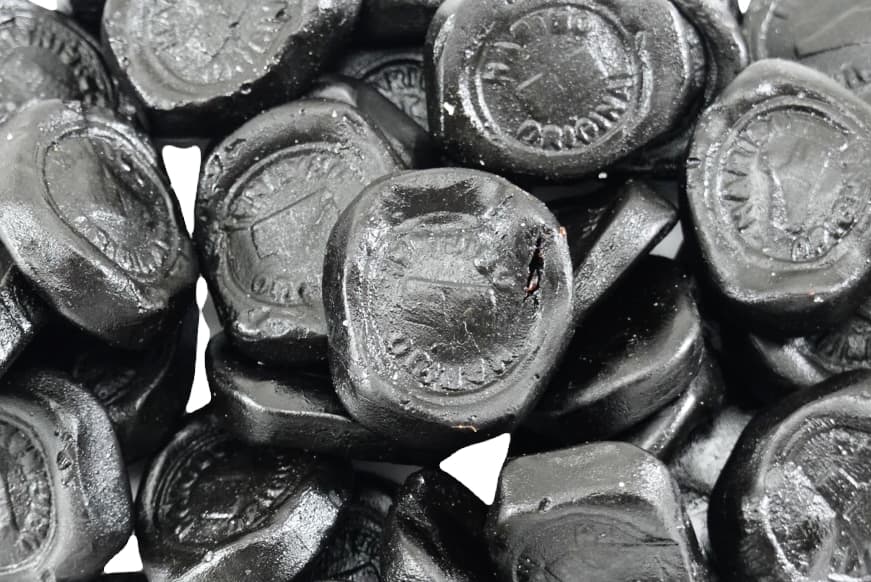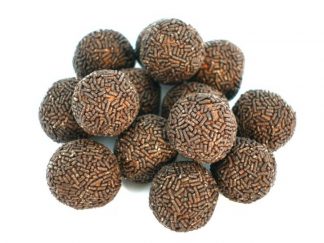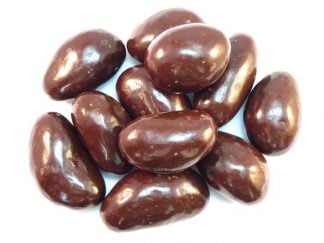
Delve into the enticing world of candy history, where the mystique of liquorice and Pontefract cakes unfurls. This blog post guides you on a sweet journey back in time, featuring liquorice cultivation, the birth of Pontefract cakes, and their enduring popularity. Ready for a treat? Let’s go!
What Exactly are Pontefract Cakes?
Taking center stage in our tale of liquorice is a chewy, delightful confection known as Pontefract cakes. Contrary to what their name might suggest, these are not cakes as we typically understand them. These tiny, circular sweets owe their origins to the soft liquorice root, and have been savored by sweet-toothed Britons since the 18th century. The most distinguishing feature of these delectable treats is the unmistakable stamp of Pontefract Castle, a nod to their heritage. This characteristic mark etched onto each sweet is a delightful detail that elevates these confections from simple candies to a historical symbol, making each bite a blend of mouthwatering flavor and centuries-old tradition. So the next time you enjoy a Pontefract cake, remember: it’s more than just a sweet treat – it’s a taste of history, lovingly preserved in soft liquorice.
A glimpse into the history of Liquorice
Travel back in time more than 5,000 years, and you’ll find liquorice being praised for its medicinal qualities in ancient societies. The Egyptians and Greeks recognized the sweet root of the plant as a remedy for various health concerns. Fast forward to the Middle Ages, and liquorice finds its way to the British shores. Loved not just for its therapeutic properties but also for its distinct, sweet flavor, liquorice quickly became a fixture in traditional British sweets. Its popularity grew in leaps and bounds, making it a beloved ingredient in a multitude of delectable confections. Today, liquorice continues to be a beloved flavor in candies across the globe, its rich and complex history as intriguing as its unique taste.

Liquorice production in Pontefract
In the quaint, historic market town of Pontefract, nestled in West Yorkshire, England, the conditions were just right for the cultivation of liquorice. The combination of fertile soil and a favorable climate made it a perfect home for this sweet, medicinal plant. As the story goes, it was the monks from Pontefract Priory who first decided to harness these conditions in the 16th century, introducing liquorice into the local agriculture.
Over time, the humble liquorice plant thrived in Pontefract’s nurturing landscape, leading to sprawling fields of the dark-leaved plants. As the plants flourished, so too did the town’s reputation for quality liquorice, becoming an integral part of Pontefract’s identity. This agricultural prowess laid the groundwork for the birth of Pontefract cakes, forging a direct link between the fertile fields of West Yorkshire and the sweet treat that would soon be recognized and enjoyed across the nation, and eventually, the world.
Just picture it: the sun-drenched fields of Pontefract, brimming with lush liquorice plants, their long roots just waiting to be harvested and transformed into the soft, sweet core of the celebrated Pontefract cakes. It’s the heart of our story, a testament to the beautiful blend of nature and culinary tradition that culminates in a timeless confection. This rich agricultural heritage continues to echo in each and every Pontefract cake, a sweet testament to the town’s unique history and enduring influence.
Pontefract Cakes
Venture back to the 17th century and meet George Dunhill, a trailblazing chemist hailing from Pontefract. In a stroke of genius, Dunhill concocted an idea that forever changed the trajectory of local confectionery: he introduced sugar into medicinal liquorice lozenges. This seemingly simple act was revolutionary, transforming the bitter-tasting, medicinal lozenges into delectably sweet confections. These were the initial iterations of the now-famed Pontefract cakes.
The sweets took the town and subsequently the country by storm, quickly finding favor among Britons with a penchant for the unique flavors of soft liquorice. These enticing little cakes began to command such a following that they spurred the establishment of numerous liquorice factories across the town of Pontefract. The demand was so high that Pontefract’s landscape began to alter, peppered with factories churning out these iconic sweets. This emergence of a bustling industry centered on Pontefract cakes was a testament to Dunhill’s innovation and the town’s prolific liquorice cultivation.
In essence, the birth of Pontefract cakes was not just the inception of a beloved candy, but also the cornerstone of a vibrant local industry. This delightful chapter in Pontefract’s history reveals the evolution of a medicinal herb into a sweet treat, owing much to the foresight of a local chemist and the fertile Yorkshire soils that made it all possible. Thus, every time you relish a Pontefract cake, remember that you’re partaking in a celebration of this town’s ingenuity, tradition, and the sweet fusion of medicinal science and confectionery.
The Significance of the Pontefract Castle Stamp
A closer look at a Pontefract cake will reveal a distinctive stamp, an etching of the iconic Pontefract Castle. This isn’t just a charming addition to the design. The emblem acts as a meaningful link, connecting the sweets to the remarkable history of Pontefract. This town was not just any ordinary place, but a significant stronghold in England, with its castle playing a critical role in its historical narrative. The castle stamp acts as a tribute to this storied past and the vital role the town has played in liquorice cultivation and confectionery history.
Just as the Pontefract cakes serve as a treat to our taste buds, their embossed stamp also provides a visual feast, bridging the gap between the past and present. Every bite of these sweets does not just offer a rush of delightful flavors, but it also resonates with echoes of a significant historical heritage. This intricate detail breathes life into the legacy of Pontefract’s rich past, ensuring that each piece of confectionery is not just a delight for the senses, but also a testament to the tradition that makes Pontefract cakes genuinely unique.
The stamp, therefore, is more than just a pretty picture – it’s an emblem of Pontefract’s standing in England’s history and its deep-rooted association with liquorice cultivation. Each sweet, with its detailed imprint of the castle, holds a piece of this narrative, making it much more than just a candy, but a celebration of the town’s storied past and enduring influence. So, as you savor a Pontefract cake, remember that each one carries with it the legacy of a town that has been intertwined with the story of liquorice for centuries. It’s a flavor-filled journey into a rich historical tapestry, encapsulated in every soft, sweet bite.
The enduring popularity of Pontefract Cakes

Pontefract cakes have firmly stood the test of time, keeping their allure alive and thriving through the centuries. These soft liquorice sweets continue to be relished and revered, not only in their homeland of Britain, but also by liquorice enthusiasts across the globe. The growth in their fanbase is a strong endorsement of their consistent charm and distinctive flavor.
Even as their production has expanded beyond the borders of Pontefract, the cakes have not lost their unique appeal. Every mouthful continues to bring a rush of nostalgia, transporting you back to the fertile fields of West Yorkshire and the bustling liquorice factories of Pontefract. They’re not just a candy; they’re a taste of tradition and a sweet reminder of a town deeply rooted in liquorice cultivation.
Today, their fame reaches far and wide, making them an emblem of classic British confectionery. Their quaint stamp of Pontefract Castle and soft liquorice core have endeared them to generations of candy lovers, preserving their status as a beloved treat. But the allure of Pontefract cakes lies not only in their taste but also in their fascinating story – a story that spans centuries and civilizations, and is encapsulated in every chewy, flavorful bite.
Despite changing candy trends and the advent of countless new flavors, Pontefract cakes have remained steadfast, a delicious beacon of tradition and heritage. Their enduring popularity is a testament to their unique charm and the unforgettable taste journey they offer – a journey that begins in the sun-drenched fields of Pontefract and ends in a burst of soft liquorice flavor. From young sweet-seekers to seasoned candy connoisseurs, Pontefract cakes continue to capture hearts and taste buds, proving that some things – like these unique sweets – never go out of style.










